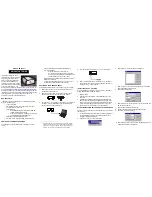
8/18/2021
LMU-2600 Hardware & Installation Guide - PULS Wiki
https://puls.calamp.com/wiki/LMU-2600_Hardware_%26_Installation_Guide
34/44
Installers are looking for the 3D-RTIME setting along with a valid Lat, Long pair (i.e. something other than 0).
If the GPS receiver does not have a valid lock within 2-3 minutes, installers should check antenna placement
(see the Installation Notes section for placement suggestions), the antenna connector and that the antenna has a
clear view of the sky. For further troubleshooting, installers should contact CalAmp Support
([email protected])
5.4.3 Inbound Verification
The last item to verify is that the LMU-2600™ is sending data to the correct server. In general, this is a two-
step process that will need the aid of an observer on the back end. That is, a technician will have to be logged
in so they can monitor data coming into the backend mapping/vehicle management application.
First, verify that the LMU-2600™ is using the correct Inbound IP address by using:
AT$APP INBOUND?
The response should be similar to:
INBOUND LMD
INBOUND 0 ADDR ddd.ddd.ddd.ddd:ppppp *
INBOUND 0 URL myURL.myCompany.com
INBOUND 1 ADDR 0.0.0.0:20500
INBOUND 1 URL
INBOUND 2 ADDR 0.0.0.0:20500
INBOUND 3 ADDR 0.0.0.0:20500
The installer will need to verify with a backend technician that the, URL (myURL.myCompany.com ), IP
address (ddd.ddd.ddd.ddd) and port (<ppppp>) are correct.
The second step is to verify that the LMU-2600™ is sending data. The best way to do this is to force the
LMU-2600™ to send in an unacknowledged Event Report (i.e., its current GPS location) with the following
command:
AT$APP PEG SUNRPT 255
The LMU-2600™ will respond with: OK
The backend monitor must then be contacted to confirm that they received an Event Report with Event Code
255.
Assuming that all three sections have passed, the installation can be considered to be complete.
5.4.4 Verification via SMS











































